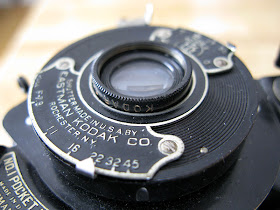
Kodak marketed the Kodar lens as a mid-level product, situated between the older standard Rapid Rectilinear and the later three-element Anastigmat design. The Kodar does a very credible job of making images, though I would be hard-pressed to distinguish them from those from the Rapid Rectilinear. What really appeals to me about this camera, however, is the fact that the aperture can be stopped down to f45. That means 400-speed film can be used at the top 1/50 shutter speed in direct sunlight, and in low light one can still use small apertures with good depth of focus.

I usually make some minor modifications to my old Kodak folders to make their use more practical. A flap of black tape covers the ruby window except when I am advancing the film. A lensless eye-level finder taken from another old camera is held in place with duct tape, and it makes composition considerably easier than using the squinty little reflex finders. A depth-of-field table for the particular lens shows the hyperfocal distance and assists in establishing the range of sharp focus at different f-stops.

I tend to employ cable releases with my old folders at it is easy to jiggle the camera using the lever release out near the lens. A lens hood would also be a good idea with the uncoated lens, but it still produces nice contrast and sharpness as long as you don't angle it too close to the sun. As may be seen in the last photo, I haven't yet stamped out all the light leaks.



Wow, a Kodak folder that takes 120! I have to tell you, I curse Kodak for that infernal 620 boondoggle every time I want to shoot one of my Kodak folders.
ReplyDeleteBut one thing I find shooting old cameras is that they teach me about the mechanics of photography. I came to collecting because I was fascinated with the equipment, not because I was a photographer. Your DOF table taped to the back of this Kodak is great. It makes me want to learn more about focal lengths and such so I can figure out my own tables and get better results from my old cameras. Right now, I guess a lot. As you can imagine, I guess wrong much of the time!
Kodak equipped some of its better quality scale-focus cameras with depth of field calculator dials. The ones on the Retinas and the Duo-620 are handy and tolerably accurate. The one they put on the Kodak Monitor was wildly optimistic. There are quite a few on-line dof calculators that can be googled. They provide accurate results for any focal length.
ReplyDeleteMike, again very nice results from your old Kodaks. Thanks for the information about the cameras. Your precautions, especially shooting with a cable release, are important.
ReplyDeleteI don't own a single 620 camera, even though my first shot ever was made using a Hawkeye Flash. IIRC, it took 120 in the loading spool.
Thanks for the tip about Googling DOF calculators.
ReplyDeleteI just got a Monitor Special in good nick, so thanks also for the insight into its DOF dial.
I'll look forward to seeing your results from the Monitor; it's probably the best quality 6x9 that Kodak made. The Supermatic shutter with its 1/400 top speed is sturdy and reliable. The 4-element Anastigmat Special lens is outstanding.
ReplyDeleteThe auto frame counting and double-exposure prevention features seem like good ideas, but seem to me to make the camera's operation a bit more fussy than needed. I have the same lens and shutter on my Vigilant and prefer it for its simplicity of operation.
I made a minor mod to my Monitor to accept 120 film rather than 620. I'm a bit sorry for that now as I have found all my 6x9 cameras really like re-rolled 120 to 620 better.
I had not considered cable release thankks for mentioning it. I am just starting out on film and I have so much to learn.
ReplyDelete